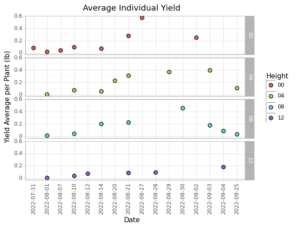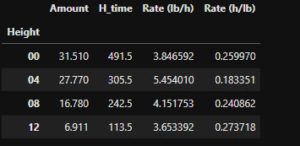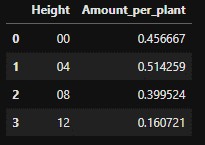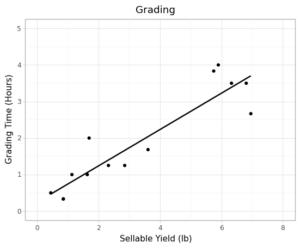Final report for FNE22-016
Project Information
Ground cherries are a unique and tasty fruit that the public is interested in, but the harvest labor has not allowed them to be profitable for farmers. In this project we used 4, 8 and 12 inch inverted V shaped beds to allow the ground cherries to drop and roll into easy to harvest piles. Time, weight and sellable conditions of the ground cherries were recorded. The 4 inch inverted V condition yield the quickest harvest rate with 5.45lb able to be harvested in one hour. About 0.5 lb of ground cherries over the season per plant for the 4 inch inverted V bed was best. Peak Harvest appears to be in the end of August with yields rapidly declining towards the end of September. A flier for outreach was created to allow farmers to easy follow and grow ground cherries.
This project seeked to increase profitability of growing ground cherries for small scale farmers. Specifically:
- Determine if an inverted "V" bed decreases labor cost during harvest, and what size is optimum.
- Provide farmers with the yield conversions needed for consumers and direct marking buyers like bakers interested in producing value-added pies and jellies
By detailed record keeping, the production data of each condition will help to determine yields, labor requirements and most productive growth condition to formulate crop budgets. Ultimately, the goal is to have a high yielding, profitable crop for small farms.
Ground cherries are a low growing, heat loving member of the Nightshade family. A ripe fruit is golden and hidden in a dried husk and drops to the ground. Ground cherries are a unique and tasty fruit that the public is interested in. During 2021, it was the only product that we repeatedly sold out of at markets and did not have enough to sell to interested bakers and restaurants. Parents loved that their kids really enjoyed this healthy alternative to sweet snacks. Adults would explain they liked having to take the husk off to get to the tasty ground cherry to slow down their eating, and when watching TV ate them instead of less healthy potato chips. Considering our nation’s poor eating habits, the small change of swapping junk food for ground cherries can make a positive health impact.
With its high pectin level, it would make a great value-added product for farmers with pies and jellies. However, a significant number of ground cherries would be needed for just a single pie, so a marketable number of pies would require improvements to the labor and growing efficiencies of ground cherries.
Ground cherries have a long shelf life of about three weeks, compared to other vegetables and berries so if a market has low attendance due to weather, the farmer can carry them forward the product to the next market. This helps reduces the risk of crop loss due to low sales, which is especially important for small scale farmers.
Unfortunately, due to the labor costs involved in harvesting, this crop was not a profitable item for our farm, despite commanding high prices. The current method of harvesting ground cherries is extremely labor intensive and physically demanding. As a result, ground cherries are less profitable than other fruit and vegetables. Additionally, despite them being our most popular item in 2021, I could not adequately scale to meet the demand gap due to this high labor cost.
Ground cherries have been cultivated in North America since indigenous times, but a variety of factors have prevented commercial success. Foremost among these factors is the time-consuming process of manual harvesting and grading. I strongly believe that if the harvest labor challenge is overcome, ground cherries would become a popular crop among consumers and provide a profitable crop for the small, hand scale farmer.
In the Northeast region, data about ground cherry yields is limited and highly varied, introducing difficultly for farmers trying to develop accurate crop budgets and labor. Additionally, during 2021, I observed highly variable weekly yields based on productivity, weather, and climate. Plotting this granular data and providing it to farmers would help in planning labor and potential sales.
Another difficulty is a lack of data about conversions between weights and measures used in harvest and those used in culinary recipes. Most of the ground cherry pie and jelly recipes use measurements based on ground cherries removed from husk, which can vary significantly from the weights and volumes often tracked by farmers who leave the husk on to protect the crop, improve shelf-life and not be a processed food. This makes it difficult for farmers to price and sell appropriate quantities for consumer use which can cause frustrations for consumers.
During an extreme rainy period in 2021, soon after I noticed large increase in crop loss due to split ground cherries. This split was similar to how tomatoes splitting after increased rainfall and indeed our tomatoes from this time period also suffered losses. Because of the husk surrounding ground cherries, visual inspection for splits is not possible, and instead one must feel for splits through the husk which is a laborious process.
During 2021, I noticed that the dropped ground cherries will cluster near each other and often roll downhill until they hit something and stop even on just a gentle slope. As a result, I hypothesize, that the use of a specifically designed, steeper raised bed (which I will call an inverted ‘V’ bed), will allow the mature fruits to drop, roll, and collect at convenient harvest locations. In addition, we will line the bed with a plastic mulch, which will decrease excess watering and reduce the potential for splitting. This project in passive collection would reduce labor costs and crop losses, increase profitability for the farm.
I believe that the cost resulting from this custom bed preparation and harvest will be less than the labor cost involved in using standard beds and harvest.
Serenity Grove Farm is a compact farm situated on a 4-acre residential plot in Frederick County, Maryland. Established in March 2020 (planned before the pandemic), Serenity Grove Farm sells at a Farmers Market and a couple wholesale customers. The owner, Jenni Hoover, runs the operation from seed to harvest, and has a Master of Science in biology and experience in quality control/ laboratory research. Serenity Grove Farm offers produce ranging from classic carrots to the more unique ground cherries futured in the grant. Previous experience growing ground cherries the year prior.
Cooperators
- - Technical Advisor
Research
Aunt Molly’s Ground Cherry seeds from Baker Creek Heirloom Seeds (packed in 2020) were started in 72 cell 1020 trays with dome on March 22, 2022 on heatmats about eight weeks prior to last frost. After nearly 100% germination, trays were transferred to LED grow lights with air temperatures no lower than 55 degrees F with a 60-70 degree F average temperature. As weather allowed, near last frost, they were hardened off outside till outside fully.
Experimental conditions:
Inverted 12-inch V raised bed with plastic
Inverted 8-inch V raised bed with plastic
Inverted 4-inch V raised bed with plastic
Standard 4-inch raised bed with no plastic (control)
Each condition was replicated three times and in a completely randomized block design. The location of each condition within the experimental plot was randomly assigned to minimize the variance of microclimates. All beds were as close to each other as possible to maintain weather and other conditions. The raised beds and controls had the same nutrients and were new for the 2022 season to eliminate crop rotation or nutrient variance concerns. Each growing condition had a bed 50 feet long via 30 inches wide. Aunt Molly’s ground cherries were transplanted with two feet spacing resulting with 25 plants per condition. Transplant death was initially high and plants were replaced. By harvest, there was no noticeable difference between the initial and replacement plants. Transplant death will be discussed further in another section.
Experimental bed preparation included using a shovel to form the beds using soil from the 30 inch wide beds into the inverted V raised beds. Drip tape was applied and secured at the top with six-inch heavy-duty staples of the inverted V about every 20 feet. 1 mil black plastic was secured via six- inch heavy-duty staples, instead of soil covering the edge to provide a cleaner landing location for the ground cherries. Additional staples were later added over the black plastic to secure the drip tape in place as a result of it sliding down the inverted V raised bed.
The height of the inverted V raised bed were measured at the beginning and end of the season. For all conditions we will measure the time spent harvesting each bed using a phone-based timer app. Hand harvesting of the ground cherries occurred. The attempt at using a broom to sweep and gather ground cherries was not practical with having ground cherries dropping off the black plastic.
Ground cherry plants received a minimum of one inch of water per seven days. During the initial transplant, they received additional. Very little additional watering was needed besides natural rain. Rain penetrated the plastic mulch and provided sufficient water to the ground cherry plants.
The inverted V raised beds were covered with black plastic mulch for several reasons. First, the black plastic mulch will reduce erosion over the season to secure the slope and preserve the height. Second, the plastic will provide a smooth surface for the ground cherries to roll down, enabling easy collection.
Harvest occurred as frequently as weather and conditions allowed. Attempts were made to harvest each block of conditions before moving to the next block. Harvest occurred after the ground cherries had dried from morning dew/ rain. Each condition was harvested into its own individual container and then weighed. An average yield per plant per each raised bed condition was determined via dividing the yield by the number of plants. The harvest time per raised bed condition was recorded and again averaged per the number of plants.
The ground cherries will be taken inside and remain segregated until the ground cherry quality can be assessed and recorded. Ground cherries were individually checked for condition and determined to be sellable- yellow/golden in color with no cracks or holes. Additional categories included green (unripe), insect damage, and cracked.
The measurements and volumes part of the project occurred during the optimum production of ground cherries. Utilizing ground cherries declared sellable, measurements of one cup by volume with husky ground cherries were weighed. This cup then had the husk removed and weighed and volume measured. This will be repeated with at least three unique harvests to determine averages.
To address the primary concern of ground cherry profitability, the study focused on the weekly ratio of yield to labor over the harvest period. Due to the long period between harvests in each plot, we combined all data from each experimental condition to estimate the profitability statistic (weekly yield/ weekly labor). In addition wastage rates were calculated across all conditions to see if the inclusion of black plastic mulch or the changes in drop height affected spoilage. Due to the husk, identifying spoilage requires significant labor, to see if such manual grading impacts profitability for certain conditions, we will measure all post-harvest handling time. Finally, to help inform growers on the amount of ground cherries to plant, we calculated average sellable yield per plant for each condition. The data analysis expert conducted all analysis and data visualization using the “R” statistical software language.
Preparation of the 8 inch inverted V beds was easiest; it was fairly simple to take from the outer edges of the bed and move it to the center and form an inverted V. The 4 inch inverted V beds were more complex because it took so little soil to form the bed. Keeping the plastic mulch flat going down the bed was the most challenging; wrinkles forming can cause an area for rain to pool and degrade ground cherries. The 12 inch inverted V bed was the most difficult to form because a wider base to form a stable enough base for the inverted V meant there was minimum soil that could be used to form the 12 inches of height. Bed formation was found most effective with a shovel. An electric Sun Joe telescoping weeder/ cultivator was tried but found to not provide the precision needed.
Ground Cherries were started in 72 cell seed starting trays March 22, 2022, approximately 8 weeks prior to the last expected frost. Seed were started on a heat mat with germination chamber with ProMix seed starting soil. After germination, the germination chamber was removed and trays were kept under LED grow lights 12 hours a day, watering prior to soil drying. Seedling were hardened off over several weeks. Due to rain and a cold Spring, planting was delayed. On May 19th, flowers were present on ground cherry plants. Beds for the ground cherries were finally ready. But late May and again early June the temperature spiked to 90+ degrees Fahrenheit for multiple days in a row- providing unfavorable planting conditions for the ground cherry seedlings. The ground cherries were finally planted June 4 and 5.
Transplant death was high for the experimental conditions into the black plastic, with most death occurring within 12-18 hours. Controls experience minimum transplant death. Ultimately that was the result of drip tape sliding down from the tops of the inverted V’s preventing water from cooling the soil and plants in the proper areas. Additional staples were added above the plastic about every six feet and they remained without issues the remainder of the season. Additionally, when transplanting I did not make a large enough hole in the plastic around the seedlings resulting in contact burns to the young stems (very generous size holes needed).
Between June 6 and 17, 2022 replacement ground cherry plants were planted. About double the ground cherry plants needed for the experiment had been started, so replacements were available to then plant, with no difference in plant size or timings of harvest seen.
The very first harvest of ground cherries occurred on July 3rd with less than 13 per bed. For most farmers this is insignificant enough and not enough for even one unit to sell when beds combined, so the first low harvest were left off the statistical charts per the recommendation of the statistician.





A shorter than expected growing season of ground cherries occurred during 2022. Ground prep and bed formation was delayed due to a very chilly wet spring and then extreme heat. The season ended earlier as a result of harlequin bugs damage and/ or wet weather causing disease/ plant death. This was the first year having harlequin bugs on the farm.
Growing next to ground cherries were tomatoes. The tomatoes and ground cherries started yielding about the same time, but it took two additional weeks before the ground cherries were in quantities for market. The ground cherry harvest finished slightly before some varieties of cherry tomatoes (hybrids with crack resistance and strong disease resistance). For farms outside of Serenity Grove Farms area (Frederick County, Maryland; zone 6B), this information can be used to determine based on your tomato season, your ground cherry season.
Approximately 0.5 pounds ( 0.47lbs when husked) of ground cherries was equivalent to 1.5 cups of husked ground cherries, about the amount needed for a standard 9 inch pie.
In this project we sought to reduce the harvest labor needed for ground cherries via using 4, 8 and 12 inch inverted V shaped beds to allow the ground cherries to drop and roll into easy to harvest piles. Time, weight and sellable conditions of the ground cherries were recorded. The 4 inch inverted V condition yield the quickest harvest rate with 5.45lb able to be harvested in one hour. About 0.5 lb of ground cherries over the season per plant for the 4 inch inverted V bed was best. Peak Harvest appears to be in the end of August with yields rapidly declining towards the end of September.
I would have liked to have had more data collection points for each of the conditions to allow for better statistics and a higher degree of confidence in the results. However, this is field research and the weather during Summer 2022 was challenging and we did the best we could. The objectives were mostly met, but less so than initially desired.
We will be implementing the 4 inch inverted V beds during the 2023 grow season for ground cherries. This was the bed found to be best- and was much better than the control. I will not be out measuring all along the bed that it is as close to 4 inches though as done during the SARE project – roughly 4 inches will be sufficient. Reducing labor and improving harvest ergonomic conditions is important and improves farm moral so this was an important project. The farm will not go back to growing ground cherries in the way prior done/ control.
The public and our market audience really enjoy ground cherries. They are one of the most popular items and our customers would be disappointed if we did not grow them. So having a reasonable harvest process- even if it still needs improvement is huge.
Education & Outreach Activities and Participation Summary
Participation Summary:
A one-page flyer with the most important highlights of the project was produced. This was disturbed via email to Maryland Extension agents and is attached here. An additional composition of pictures during the project was also put together and made available. These should make it easy for any farmer to learn and grow ground cherries.
Originally, presenting the results at a conference was planned, however, was unable to be completed. It was submitted to a regional conference but it was not accepted.
Learning Outcomes
The harvesting of ground cherries is improved by using an inverted V with black plastic mulch, compared to a control with no black plastic mulch. Although more limited data than ideal, data suggested the 4 inch inverted V bed performed the best. In 2023, I plan to plant ground cherries and will be aiming to have inverted V beds between 4 and 8 inches. The 12 inch inverted V beds were more labor intense to construct, along with noticeably less yields compared to other conditions. In 2 of 3 plots, the height of the ground cherry beds had minimum height loss from preparation to end of season.
The amount of ground cherries needed to bake pies with, and to provide guidance for wholesale baker customers was a simple but important knowledge gain. Approximately 0.5 pounds of ground cherries was equivalent to 1.5 cups of ground cherries out of husk, and about 0.47 pound ground cherries (only .03lbs was husky weight). This was about the amount desired for a pie.
Ground cherries has a slow start to the season, but started producing about 10 days after the first cherry tomato plants. Production was starting to trend toward peak production about 4 weeks later. Peak production was for about 3-4 weeks. A quick decline was seen due to rain and harlequin bugs.
After sorting ground cherries postharvest, green (unripe) ground cherries were held in crate inside a basement (temperature roughly 70-75 degrees) do determine what percent would turn yellowish in color signifying ripe. Even after multiple weeks, very few turned ripe, or the ones that did had pest/other damage. It can be concluded that saving the green, unripe ground cherries to turn ripe to sell is unfeasible for commercial farms.
Project Outcomes
The ground cherry improved harvest study allowed patrons of the Farmers Market that Serenity Grove Farm attends to explorer this new to them ground cherry. This farmers market is at a workplace and coworkers would frequently share with each other, and often times would result a new customer coming out to the farmers market as a result of trying their coworker’s purchased ground cherries. As a result, the farmers market had new customers that did not previously come out and raise awareness of the farmers market. With the positive experience to ground cherries, they were then more adventurous with other more unique produce.
As the harvester of the ground cherries, I looked forward to harvesting the experimental rows and not the controls of ground cherry with new elevation. The controls were so much more physically hard on the body to harvest with the crawling on the ground under and reaching for the ground cherries. Harvesting the 4, 8 and 12 inch inverted V beds were approximately the same difficulty as each other; about as much as harvesting cherry tomatoes and way similar than the control bed. In future years, I will always utilize a inverted V bed (until another design is better) because of the ergonomics being so much better than the control.
More work on ground cherry harvest and post-harvest is still needed. This was a step in the right direction, but further studies needed. The height and width of the ground cherry plants this year was larger than has grown previously at the farm. As a result, future growing should allow for larger aisles (we had 18 in aisles). Having the ground cherries land on the plastic compared to in the aisle of dirt/small vegetation made harvest quicker and cleaner. Future studies should consider the cost benefits of having a barrier in the aisle. With this being either all ground cloth, or plastic black mulch on the beds and ground cloth in aisles. Good drainage is important, so all plastic black mulch is not a good option.
The inverter V’s were designed to have ground cherries drop and roll down- but this also meant rain did the same thing. Laying the plastic to minimize puddling where ground cherries lay is important.
The weather was our single biggest challenge. Early experiment, the ground was not workable with an unusually cool spring causing delays, followed by a hot and dry spell. Rain later in the season was multi day durations, leaving little time for ground cherries to dry and be harvested. Harvesting wet ground cherries will have nearly zero shelf life. Near the end, harlequin bugs were spotted and that might have added to the swift decline. With the late start and earlier than planned end, it caused a limited amount of harvests resulting in more challenges to do quality statistics.
Prior to this experiment, I had very little experience working with plastic mulch. So the first time planting into the black plastic mulch, errors were made. The biggest problem was plant holes were too small, not allowing for enough heat dissipation and plant stems were burned by the plastic. Additionally, the drip tape had slid down from the tops of the inverted V’s preventing water from cooling the soil and plants in the proper areas. Additional staples were added above the plastic about every six feet and they remained without issues the remainder of the season. About double the ground cherry plants needed for the experiment had been started, so replacements were available to then plant, with no difference in plant size or timings of harvest seen.
Processing time of determining greens, split, and insect damage, versus high quality ground cherries to sell was very high. It’s a delicate balance for the desire for customers to not find a bug in their ground cherry or have a green ground cherry that doesn’t have desired pineapple meets a tomato taste. But sorting each ground cherry individually results in increased labor cost; it takes about 30 minutes to sort one pound of ground cherries. Sorting individually, approximately 25% of ground cherries fell into the non-sellable categories. As a compromise, a quick sort with minimum labor to remove the obvious non-sellable ground cherries should remove about half of the low quality ground cherries.